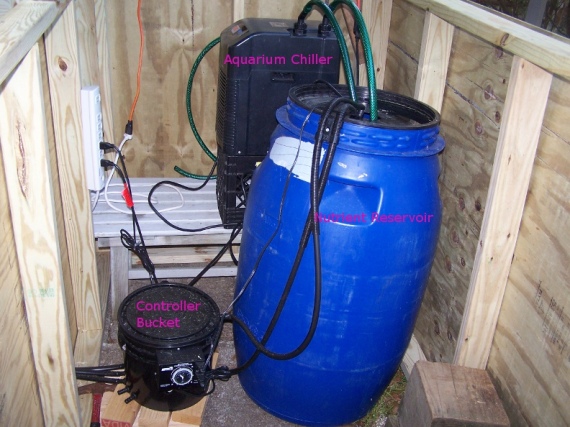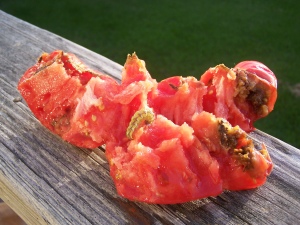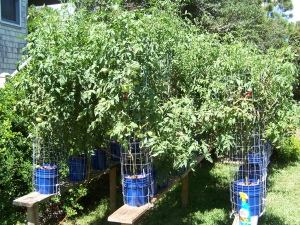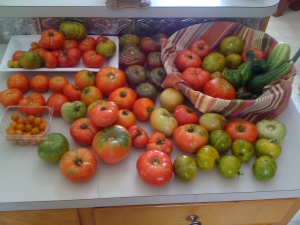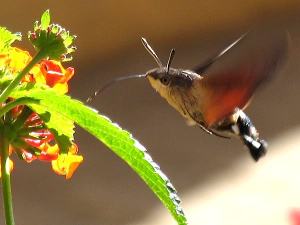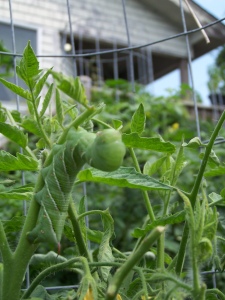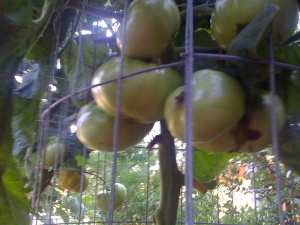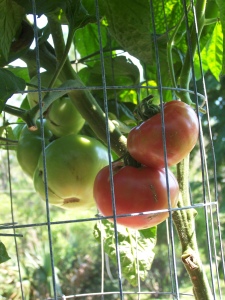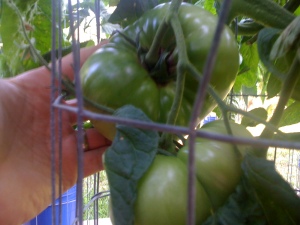The most traffic that search engines drive to this site is over the key words “tobacco hornworm” and “Hummingbird Moth”. I figured a good explanation of the worm and its cousin the Tomato Horn Worm was therefore needed.
Both the Tobacco and Tomato Hornworms feed on tomato plants, it usually assumed when you have pesky green worms on your tomatoes, they must be Tomato Hornworms. This isn’t necessarily true. Last year I had Tobacco Hornworms grubbing down my tomato plants and pooping on my pretty fruit. Here’s a brief explanation of the two, to aid in verification of which worm is eating your plants:
(web citation) Info from About.com
Tomato Hornworm, Manduca quinquemaculata and Manduca sexta

Tomato Hornworm

Adult Tomato Hornworm
Description: Early instar caterpillars range in color from white to yellow. As they molt and grow, tomato hornworm caterpillars turn to green with 8 v-shaped white marks on each side of their bodies. Tobacco hornworms differ slightly, having 7 diagonal white marks down each side instead. Both tomato and tobacco hornworms have a hornlike projection on their last segments – thus the name hornworm. Both pests are the larvae of sphinx moths, fat-bodied moths with small forewings. Eggs are oval and green, and laid singly on leaf surfaces.
Life cycle: Both tomato and tobacco hornworms overwinter in the soil as pupae. In spring, adults emerge from the ground to mate and lay eggs. When garden crops are not yet available, the adult moths will lay their eggs on other solanaceous plants, including weeds like jimsonweed, nightshade, and horse nettle. Caterpillars feed on foliage, reaching maturity within 4 weeks. The larvae then drop to the ground and pupate. A second generation of moths in midsummer, just when tomatoes and other nightshade crops are beginning to flower. These second generation caterpillars tend to do the most damage in the garden, before pupating in the soil in fall.
Crops damaged: Tomatoes, potatoes, eggplants, and peppers. Caterpillars feed on foliage and sometimes on unripened fruit.
Signs and symptoms: Defoliation of host plants, especially near the top of the plants. As caterpillars get larger, defoliation accelerates and entire plants can be devoured quickly. Frass (black or green caterpillar droppings) on lower leaves or on ground under affected plant.
Control measures:
- Hand pick caterpillars and drop them in soapy water to destroy them. This requires a good eye, as hornworm caterpillars are well camouflaged.
- Turn or till soil at the end of the season to disturb any burrowing caterpillars or pupae.
- Keep the garden free of solanaceous weeds that provide tomato and tobacco hornworms additional hosts.
- Apply Bacillus thuringensis when larvae are young.
- Attract beneficial insects, such as predatory wasps and lady beetles, that feed on eggs and young caterpillars.
- Braconid wasps parasitize hornworms. If you find a hornworm with white, cylindrical projections on its body, leave it in the garden. These are braconid wasp pupae, and more parasitic wasps will emerge from them and find other hornworms to parasitize.

- Tobacco Horn Worm

Adult Tobacco Horn Worm
"Hummingbid Moth"
Tobacco hornworm is one of the most common insects in the garden. They are scientifically known as Menduca sexta and belong to the Sphingidae family. They are the larvae of the Sphinx moth and are often confused with the tomato hornworm or Menduca quinquemaculata that belongs to the same genus but as is clear from the scientific name, is a distinct species. In order to understand the insect better, let us consider some tobacco hornworm facts in this article.
Tobacco Hornworm Facts – Habitat and Distribution
Tobacco hornworms are very common in the southern states of the United States although their habitat stretches from Canada to Argentina. The tobacco hornworm habitat include the foliage of plants belonging to the Solanaceae family. Their most favorite host is the tobacco plant. In nature, tobacco hornworm diet includes leaves of the plants that they grow on. When raised in laboratory for scientific studies, the tobacco hornworm diet is wheat-germ based.
Tobacco Hornworm Facts – Life Cycle
Tobacco hornworm life cycle is a short one that spans over 30 to 50 days. It begins with the eggs that hatch into larvae. The larvae become the tobacco hornworm pupa that finally matures into an adult. The emergence of an adult moth by the transformation of the larva is an example of complete metamorphosis. Here is a step by step account of the tobacco hornworm life cycle.
Tobacco Hornwoorm Eggs
Tobacco hornworm eggs are spherical and translucent green in color. They are mostly found on the lower surface of leaves. However, occasionally these may also be laid by the female moth on the upper surfaces of leaves.
Tobacco Hornwoorm Larva
Within 2 to 4 days after they have been laid, the tobacco hornworm eggs hatch into larvae. Also known as the tobacco hornworm caterpillars, these larvae are green in color and about 70 millimeter in length. They feed on the foliage of the plant on which the eggs were laid. The tobacco hornworm caterpillar goes though 5 larval instars or developmental stages that span over a period of about 20 days. Throughout the successive instars, the caterpillar grows in size. The characteristic horn or spike on its abdominal segment that gives the caterpillar its name also keeps reducing in length in each successive instar. As the caterpillar approaches the final stage, it starts looking for a place to burrow so that it can enter its next stage, which is the pupa stage. This behavior of the pupa is rightly termed as wandering.
Tobacco Hornwoorm Pupa
Once the tobacco hornworm larvae mature, they drop on the ground and burrow into the soil to a depth of 10 to 15 cm. Here, they form a brown or reddish-brown colored pupa which is elongated and oval with a pointed posterior end. The tobacco hornworm pupa has a pronounced maxillary loop that encase its mouth parts. This loop extends to almost one-fourth the body length of the tobacco hornworm pupa. However, in case of the tomato hornworm pupa, the case is one-third the length of the pupa. The pupal stage is long and its duration is variable.
The Adult
The adult form of the tobacco hornworms are known as Carolina Sphinx moths or hawk moths. They are sexually dimorphic and have large forewings. Their identification marks are the orange yellow spots on their abdomen. The adults feed on nectar of flowers. It is due to their powerful and rapid beating of the wings that these moths are also known as the hummingbird moths. These moths are seen hovering over flowers during dusk.
Other Tobacco Hornworm Facts
- Tobacco hornworm is a model organism and is commonly used in neurobiology due to its short life cycle and easily accessible nervous system.
- The tobacco hornworm caterpillar causes great damage to the leaves of a tobacco plant. Just two such caterpillars can defoliate an entire plant.
- The distinguishing feature between tobacco hornworm and tomato hornworm caterpillars are the markings present on their bodies. While the tobacco hornworm has white diagonal lines, the tomato hornworm has V-shaped markings on its body.
- Tobacco hornworm caterpillars can be controlled using insecticides. Read more on pest control.
- Natural enemies include the stilt bug Jalysus spinosus that attack hornworm eggs. The braconoid wasp is a tobacco hornworm predator that lays eggs in the hornworm. As the eggs hatch, they eat their way out of the caterpillar slowly killing it.
One of the alarming tobacco hornworm facts is that due to their voracious appetite, these insects are one of the most destructive pests of the tobacco plant . If their growth is left unchecked, then tobacco hornworms are capable of destroying an entire crop.

Defoliation

Fruit Damage
Larvae are defoliators, usually attacking the upper portion of plants initially, and consuming foliage, blossoms and green fruits. They usually consume the entire leaf. Because the larvae of hornworms attain such a large size, they are capable of high levels of defoliation. About 90% of the foliage consumption occurs during the final instar. Larvae blend in with the foliage and are not easy to detect. Thus, it is not surprising that they often are not observed until they cause considerable damage at the end of the larval period
